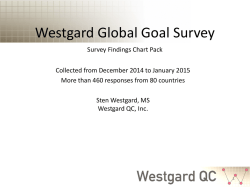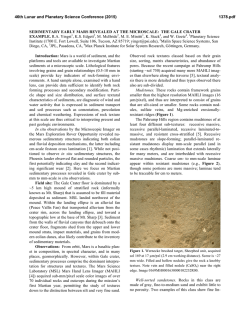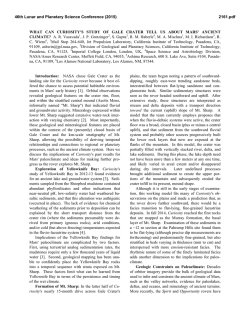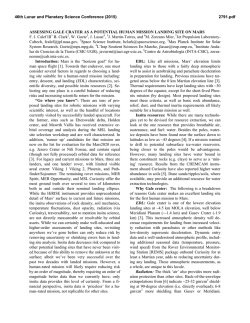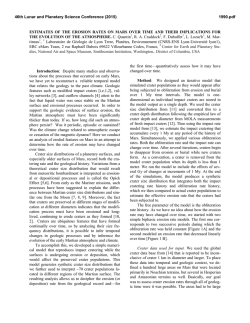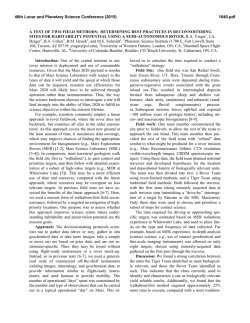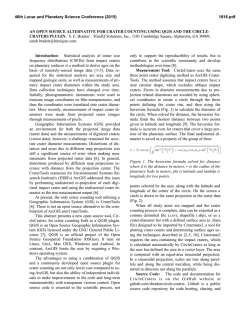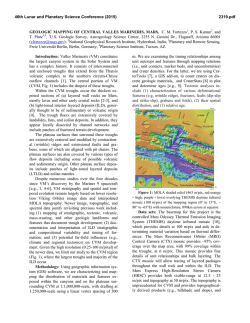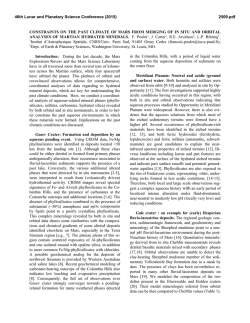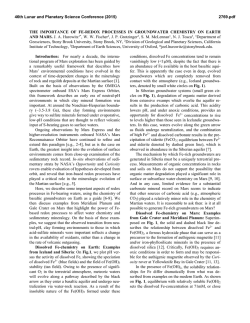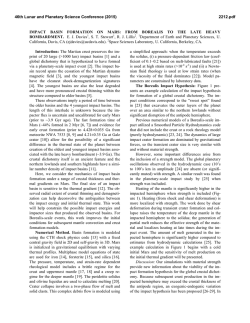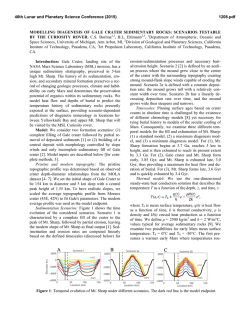
BLAST BEDS AT THE ROVER SITES ON MARS. D. M. Burt1, L. P.
46th Lunar and Planetary Science Conference (2015) 2838.pdf BLAST BEDS AT THE ROVER SITES ON MARS. D. M. Burt1, L. P. Knauth2, and K. H. Wohletz3 1School of Earth and Space Exploration, Arizona State University, Box 871404, Tempe, AZ 85287-1404, [email protected], 2 same, [email protected], 3Los Alamos National Laboratory, Los Alamos, NM 87545, [email protected]. Introduction: Ancient, variably salty, friable, basaltic sedimentary beds with relatively uniform grain sizes and prominent, remarkably shallow crossbedding have now been imaged at the Martian surface by all three Mars rovers, Spirit (MER1), Opportunity (MER2), and Curiosity (MSL). Where they have been found, these beds overlie other, older rocks. Owing to alleged analogies with terrestrial sediments deposited by wind, water, and volcanism, these beds have been variably interpreted as aeolian, fluvial, lacustrine, or volcanic, despite their highly uniform appearance and composition from landing sites to landing site. They are not usually interpreted as having possibly resulted from meteorite impact, despite the impact-dominated early history and heavily cratered surface of Mars [1]. These beds were first encountered by the Opportunity rover in Meridiani Planum, where they cover essentially the entire plain, except where still more ancient impact breccias and altered glasses were recently encountered around the edge of Endeavor Crater. Although these beds were inititially interpreted to have formed in an evaporitic, semi-marine environment, published work later attributed them to windblown salts and sands eroded from a vanished dry lake or sea, as well as to water flows in vanished streams. The uniformly-shaped and sized, generally unclumped tiny spherules that these beds contain, left behind by wind erosion as an extremely widespread lag deposit, were interpreted as concretions formed in groundwater, despite multiple features inconsistent with typical concretions and distinctive other features inconsistent with the presence of groundwater [2][3]. they contained no spherules, a spherule-rich bed did occur stratigraphically just underneath. On the basis of a single putative bomb sag, these beds were interpreted as resulting from a volcanic explosion or explosions, despite the evident lack of any possible volcanic source area in the vicinity. Fig. 2. Outcrop ‘Home Plate’ Gusev Crater (NASA/JPL). A third occurrence of these distinctive beds, in places coarser grained than at the other two localities (although similarly coarse material does occur locally at Meridiani Planum and Home Plate), was initially discovered by the Curiosity rover at a thin, poorlyexposed outcrop named Shaler in Gale Crater. On the basis of being partly too coarse to attribute to wind, some of these beds were interpreted as fluvial (resulting from flowing water in a stream), despite the complete lack of any features consistent with stream deposition (e.g., channels, beds grading vertically or laterally into shales, variable clast sizes, dewatering textures, etc.). Where finer-grained, the beds were interpreted as wind-deposited. Similar beds, found all along the rover’s traverse to date, have been similarly interpreted. Fig. 1. Outcrop ‘Payson’ Meridiani Planum (NASA/JPL). Highly similar beds were later discovered by the Spirit rover at Home Plate in Gusev Crater, apparently draped over a small crater or depression. Although Fig. 3. Outcrop ‘Shaler’ Gale Crater (NASA/JPLCaltech/MSSS) 46th Lunar and Planetary Science Conference (2015) Given the essentially identical nature of these beds, it seems only logical to attribute them to a common depositional process. We have suggested [2][3][4] sedimentation by turbulent clastic density currents resulting from impacts. For conciseness and clarity, we here and [5] suggest calling them blast beds. Other possible names are impact base surge deposits or dilute impact density current deposits. Recently, Boyce et al. [6] [7] and Barlow et al. [8] have suggested that similar, albeit very much younger, blast beds formed by the same mechanism may be widespread on Mars in the form of LARLE (Low-Aspect Ratio Layered Ejecta). Blast Beds and Spherules. Owing to the presence of an atmosphere and of abundant subsurface volatiles (mainly as ice) on Mars, impact cratering on Mars should was distinct from impact cratering on the Moon and Mercury. However, Mars need not have much resembled ancient Earth, because Mars has always been very much smaller and farther from the Sun. On Earth, cross-bedded fine-grained sediments, locally containing various types of small spherules (glassy condensates and accretionary lapilli), are known to be deposited via explosions that vary from nuclear to volcanic to impact-derived. These explosion-deposited sediments (for volcanism called base surge or, more recently, pyroclastic density current or PDC deposits) can greatly resemble sediments deposited by flowing water or wind, a fact that has led to multiple misattributions by geologists [4]. In places, overriding of obstacles and deposition on slopes (original dip and draping over topography), can help identify such sediments. Original dip (draping over topography) appears common in deposits both in Gusev Crater (Home Plate and its immediate vicinity) and Meridiani Planum (e.g., where salty sediments appear to have overridden enormous, ancient Endeavor Crater prior to partial erosion. Some exposures of cross-bedded sediments in Gale Crater also seem to over-ride topography, scouring it in the process. Deposits formed by explosions can vary from wet to dry, depending on the initial steam content. Spherical accretionary lapilli typically form in relatively wet deposits, via condensation of sticky steam onto particles in a turbulent, dilute density cloud. Accretionary lapilli, unlike sedimentary concretions, tend to be strictly size and shape limited and unclumped; they also can contain high temperature minerals formed in the fumarole-like environment of impact explosion clouds. Uniformly small (up to about 5mm), and abundant spherules occur in cross-beds in various nearsurface horizons all along the Opportunity Rover traverse in Meridiani Planum.; The most common (at least 50%) phase in these lapilli (“blueberries”) appears to be the crystalline, specular, high temperature form of 2838.pdf hematite (so-called gray hematite), with detected enrichment in Ni. Other than some doublets and a linear triplet, the spherules tend to be unclumped and uniform in size (within a given horizon or erosion area). Many are broken and they may have been impact reworked, in part. Millimetric spherules of unspecified composition occur in a distinctive horizon beneath Home Plate in Gusev Crater; these were assumed to be accretionary lapilli. Finally, individual impact spherules of various types also appear to be widespread in Gale Crater, based on initial studies by Newsom et al. [9]. Other Mass-Movement Beds in Gale Crater: Socalled conglomerates (although many are more accurately described as breccias) are widely distributed in the rocks traversed to date. All have been interpreted to be ultimately fluvial, despite their obvious lack of sorting (most appear matrix-supported), lack of restriction to channels, and highly inconsistent degree of clast rounding. Note that clast rounding simply implies prolonged abrasion (e.g., via long runout inside a large crater), not necessarily a liquid water transport medium. Therefore mass movements of some sort would seem to provide an equally plausible origin. So-called mudstones or lake beds are poorly sorted, also basaltic in composition (like average Martian soil [10]), and clay-poor (about 20%, described as probably authigenic [10]). What clay is present is described as probably saponite (a primitive trioctahedral smectite) [11]. The highly heterogenous aspect, primitive chemical nature, massive bedding style, and other features again suggest to us these masses could be mud flows or other mass movements rather than lake beds. Conclusion: Deposition by dilute impact-related density currents seems to require either a volatile-rich target or an atmosphere or both, and Mars certainly possesses both. By the end of Noachian, when the cross-bedded distal impact deposits (our interpretation [2]) and spherules at Meridiani Planum, Home Plate (Gusev Crater), and presumably Gale Crater formed, Mars was already mostly dry and cold. Available surface evidence at all three sites gives no unambiguous indications of flowing or standing surface or subsurface water. Mars remains an impact-dominated planet, and attributing some of its most interesting sedimentary features to wholly Earthly causes appears to be a mistake. References (most older ones omitted): [1]. Burt, D.M. et al. nd (2011) 2 P.C.C. Mtg., abstr. 1108. [2] Knauth L.P. et al. (2005) Nature, 438, 1123. [3] Burt D.M et al. (2006) Eos, 87, 549. [4] Burt D.M. et al. (2008) JVGR, 177, 755. [5] Burt D.M. et al. (2013) 4th P.C.C. Mtg, Abstr. #1313. [6] Boyce J.M. et al. (2013) LPSC 44, abst. 1004. [7] Boyce J.M. et al. (2015) Icarus 245, 263-272. [8] Barlow N.G et al. (2014) Icarus 239, 186. [9] Newsome H.E. et al. (2015) Icarus (accepted). [10] Wiens R.C. et al. (2014) 4th Int. Conf. Mars, Abstr. #1170. [11] Morris R.V. et al. (2014) 4th Int. Conf. Mars, Abstr. #1370.
© Copyright 2026
